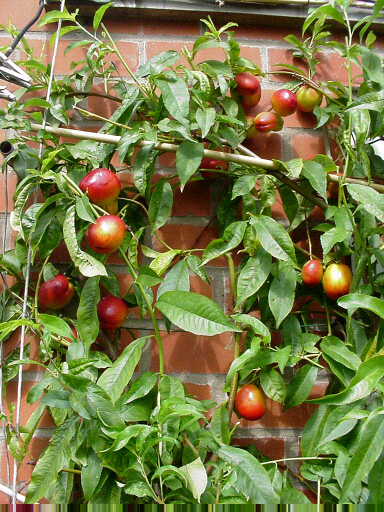
Growing Peaches in Leicestershire
It is by no means certain that a peach tree growing in the Midlands will have a crop every year. The main obstacle to this is frost; the blossom is very susceptible to damage by cold weather. But let's start at the beginning.
To grow peaches in the Midlands you need a south- facing wall which receives plenty of sunshine. You may prefer to buy a tree from a nursery but peaches (and nectarines) are one of the few fruits which can be grown successfully from a stone. If you do this choose the stone from a particularly good flavoured fruit and crack it before setting. Grow it in a small pot, then a larger pot, and when about 18 inches high, plant it outside.
Once the tree is established you'll find that the main problem is its unpredictable growth. In this area peach leaf curl affects the leaves very badly in May and early June, and lowers the vigour, but careful removal of the affected leaves and regular spraying over the winter with Bordeaux mixture helps a good deal.
Depending on the quality of your soil it may be a good idea to constrict the roots. Some peach trees produce too much wood because the roots grow unrestricted. But there are other ways of keeping the tree under control; for example, arching branches - and this is the method I use. It has the advantage that plenty of new wood is produced each year and this helps to offset the loss of vigour caused by peach leaf curl.
When the blossom in flower it is likely that insect pollination will not occur. It will probably be way too cold for bees and other insects to do the job. What you must do is get a very fine artist's soft paint brush and every other day, carefully transfer pollen from one flower to another to enable the fruit to set.
I have found in Leicestershire another trick to help ensure a crop each year. It's not enough to train a peach tree against the south wall and to expect it to fruit. If there is a frost when the tree is in blossom, if the flowers are more than an inch or two away from the surface they will receive little protection. What I do is pull the branches hard back to the wall and tie them in position. I have screwed four brackets to the wall for this purpose. There seems to be a a boundary layer of warmth which stretches about half an inch (and only half an inch) from the wall's surface during a frost. If you can ensure the branches are pulled hard back to the bricks they will receive good frost protection. You should also put a fine net or fleece over the tree, which will give it an extra degree or two of warmth. The frosts at this time of year are usually light and not too difficult to ward off.
One of my peach trees is actually a nectarine. This is a smooth - skinned variant of the peach; for those of you who know a little about genetics smooth skin is recessive to downy skin and a nectarine is simply a double recessive peach with respect to skin type. There are other characteristics you may notice about peaches; the colour of the flesh and whether or not the stone is easily removed, for example, but the most obvious distinction between different peaches is the texture of the skin.
Peach trees like a slightly limey soil; they suffer from die-back, and if you forget to spray with Bordeaux mixture you will have a lot of trouble in the spring with leaf curl, but home-grown peaches, even in the Midlands, have a more concentrated flavour than imported foreign fruit. It is reckoned that a fruit needs about one square foot of healthy foliage to produce it, so a small fan-trained tree in a good year measuring, say, 7 ft square, ought to give you a couple of dozen fruit, at least, each year. Here's part of my tree (grown from a stone) as it was last year.
Good luck!

Nigel Deacon, Diversity Website.